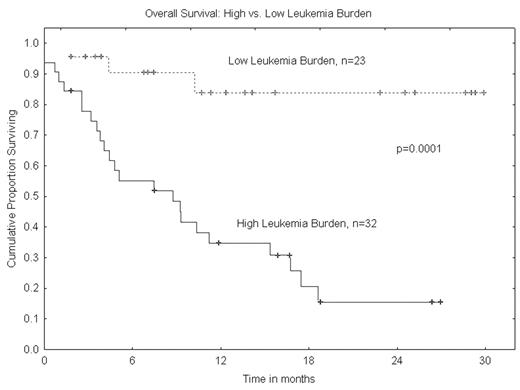Abstract
Fludarabine melphalan conditioning has been used widely for conditioning of pts with hematologic malignancies. When combined with in vivo alemtuzumab, this regimen leads to reliable engraftment, minimal acute and chronic GVHD, and low early transplant-related mortality (TRM). Between 2002 and 2004, we conducted a prospective study in hematologic malignancies. Here we report outcomes in 55 patients with high-risk myeloid malignancies. Median age was 54 (range 17–71); 17 were 60 and older. 28 had HLA-identical related donors, 23 had MUD donors, and 4 had 1 Ag-MM related donors. 32 pts had high leukemia burden at transplant (24 active AML, 6 MDS with >5% blasts, 1 CML-BC, 1 myelofibrosis in transformation). 23 pts had low leukemia burden at transplant (4 AML in CR1 with adverse cytogenetics, 2 AML CR1 with WBC>100K, 1 AML CR1 requiring 2 inductions, 6 AML CR2, 1 AML CR3, 4 MDS <5% blasts, 2 CML-CP gleevec refractory, 1 CML-CP gleevec intolerant, 1 myelofibrosis, 1 PNH). ECOG performance status (PS) was > 0 in 20 pts. Many had other high risk features including 15 with prior transplant and 10 with secondary leukemia. Conditioning consisted of fludarabine-melphalan-alemtuzumab (as per Smith, Blood 2002, abstract 5292), with tacrolimus for GVHD prophylaxis until day 100. Stringent CMV prophylaxis with high dose valacyclovir was given for 180 days. There were two early graft rejections (both from1 Ag-MM related donors) and both pts died of aplasia. There were also 2 deaths during conditioning. Including these 4 pts, cumulative day 100 TRM is 17% (95% CI 7–27). Median follow-up for survivors is 14 months (range 2–30). Estimated one year survival is 53% (95% CI 39–67) and one year PFS is 44% (95% CI 30–68). Donor type did not affect survival. Age > 55 (HR 2; p= 0.04), PS > 0 (HR 2.4; p= 0.001) and high leukemia burden (HR 7.7; p=0.0001) were associated with decreased survival in univariate analysis. 20 of 23 pts with low leukemia burden remain alive, 18 in ongoing remission. By contrast, one year survival for pts with high leukemia burden is 35 % (figure). Only 1 case of grade III–IV acute GVHD was observed and extensive chronic GVHD occurred in 3 pts. CMV reactivation was common, but documented CMV pneumonia occurred in only one patient. Fludarabine melphalan alemtuzumab conditioning results in excellent long-term outcome for patients with high-risk myeloid malignancies and low leukemia burden, with a very low incidence of acute and chronic GVHD. In these disorders, GVHD is not a prerequisite for achievement of durable CR. For pts with high leukemia burden, therapy provided mainly palliative responses with a low incidence of GVHD. Further improvements are needed to reduce recurrence rate for pts with high leukemia burden.
Author notes
Corresponding author


This feature is available to Subscribers Only
Sign In or Create an Account Close Modal